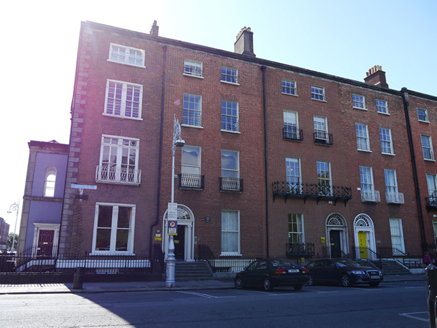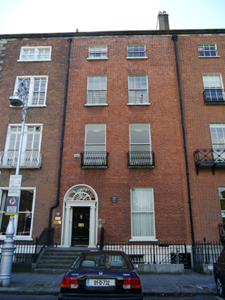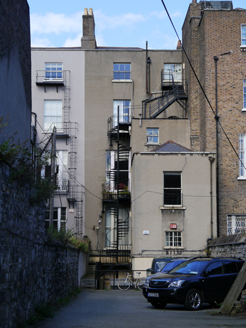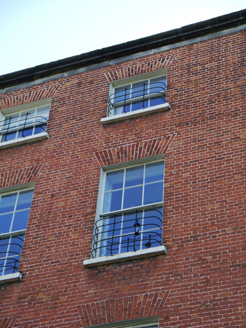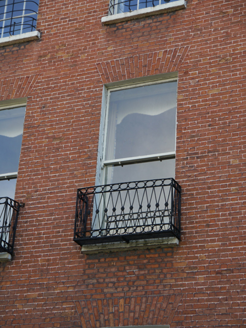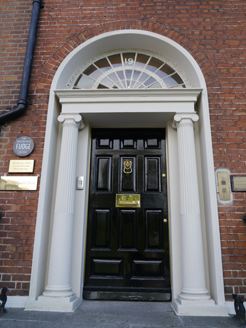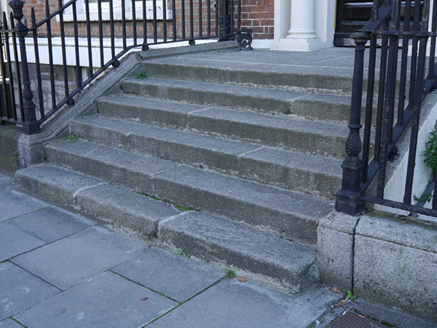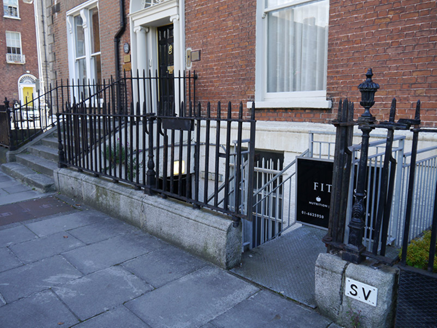Survey Data
Reg No
50930212
Rating
Regional
Categories of Special Interest
Architectural, Artistic, Historical
Original Use
House
In Use As
Office
Date
1820 - 1830
Coordinates
316511, 232989
Date Recorded
28/08/2015
Date Updated
--/--/--
Description
Terraced two-bay four-storey over basement former townhouse, built c. 1825, with two- and three-storey two-stage return over basement to rear (south). Now in use as offices. M-profile slate roof, hipped to east of rear span, concealed by ashlar granite parapet with moulded cornice and coping, shouldered rendered chimneystacks to east and west party walls with yellow clay pots, parapet gutters and cast-iron rainwater goods breaking through to east and west ends. Red brick walling in Flemish bond over coursed ashlar granite walling to basement, beneath granite stringcourse. Square-headed window openings with brick voussoirs, rendered reveals and projecting granite sills; plain rendered surrounds to rear and basement. Iron guard rails affixed to sill of third and second floor windows, cast-iron balconette to first-floor windows, metal grille affixed to reveals of basement window. Generally one-over-one replacement timber sliding sashes with horns, six-over-six to second floor and three-over-three to third floor without horns. Tripartite windows to ground and first floor rear (south); two-over-two sash and multi-paned metal casement to return. Round-headed door opening to principal elevation (north) with moulded rendered reveals and Greek Ionic doorcase having plain frieze and cornice supported on projecting di-style fluted Ionic columns, with ornate fanlight and eleven-panelled timber door. Granite entrance platform with cast-iron boot scraper, approached by six granite steps and flanked by cast-iron railings with decorative corner posts over granite plinth, enclosing basement area. Coal-hole cover to pavement. Steel steps to basement well. Metal spiral fire escape stair to rear. Ashlar limestone elliptical-headed carriage-arch with replacement brick voussoirs and stone cornice, to south boundary on north side of Kingram Place, abutted by rubble limestone wall with square-headed pedestrian gate having replacement brick surrounds.
Appraisal
Nos. 19-23 were built as a unified group by the firm of Henry, Mullins & McMahon. A typical example of the Dublin Georgian townhouse, the well-balanced proportions and restrained detailing of the principal elevation is enlivened by the Greek Ionic doorcase, a feature of this group, complemented by a variety of classically-styled doorcases across the remainder of the terrace. Retaining its original aspect to Fitzwilliam Square, the ornate balconettes, granite steps and cast-iron railings serve to enhance the overall street setting. Forming part of cohesive terrace, the subtle stylistic and material variations between the neighbouring groups of terraces highlight the speculative nature of the square’s development. The building also warrants historical interest as Robert Lloyd Praeger (botanist and author) lived here between 1922 and 1952. The south side constituted the final phase of construction, c. 1823-8, comprising terraces by three different contractors. Laid out in 1791 by the surveyors J & P Roe, Fitzwilliam Square was the last of the city’s Georgian squares to be completed. Development was staggered and progressed slowly until after the Napoleonic Wars.
